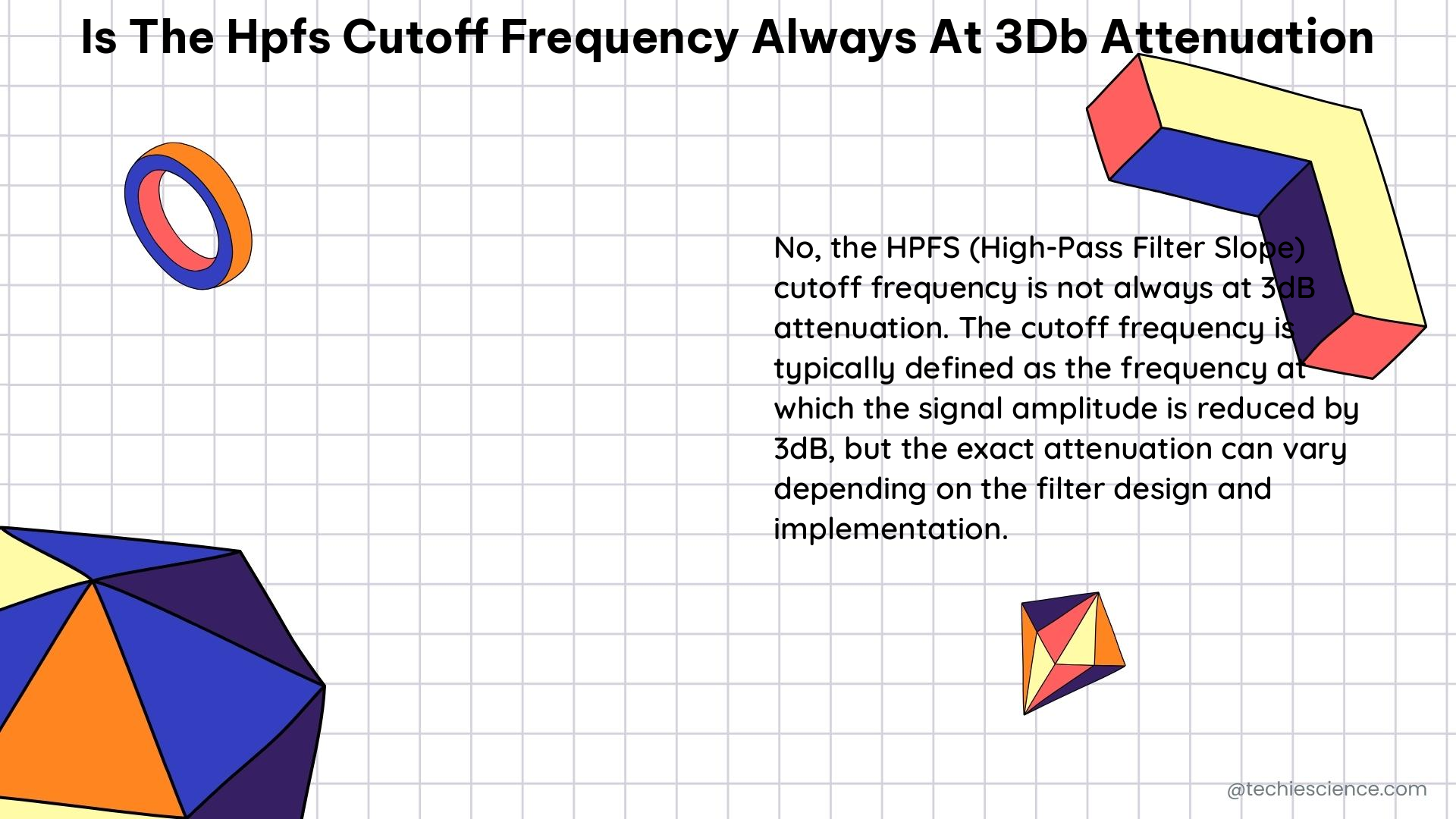The cutoff frequency of a high-pass filter (HPF) is often defined as the frequency at which the power of the signal is reduced to half its maximum power, which corresponds to a 3 dB attenuation. This convention is widely used in the field of electronics and signal processing because it provides a clear and consistent way to compare the performance of different filters.
Understanding the 3dB Cutoff Frequency
The choice of 3 dB as the cutoff frequency is not arbitrary, but rather is based on the mathematical properties of filters and the way that they attenuate signals. In a first-order high-pass filter, for example, the gain drops to 70.7% (or -3 dB) of its maximum value at the cutoff frequency. This point is often used as a reference because it represents a significant reduction in the signal level, but still allows for a reasonable amount of signal to pass through the filter.
The 3 dB cutoff frequency is defined as the frequency at which the power of the signal is reduced to half its maximum power. This is because power is proportional to the square of the signal amplitude, and a 3 dB reduction in amplitude corresponds to a 50% reduction in power.
Calculating the Cutoff Frequency

The formula for calculating the cutoff frequency (f_c) of a first-order high-pass filter is:
f_c = 1 / (2π * R * C)
Where:
– R is the resistance value (in ohms)
– C is the capacitance value (in farads)
For example, if a first-order high-pass filter has a resistance of 10 kΩ and a capacitance of 1 μF, the cutoff frequency would be:
f_c = 1 / (2π * 10,000 * 0.000001)
f_c = 15.92 Hz
This means that at 15.92 Hz, the signal power will be reduced by 3 dB, or 50%, compared to the maximum power.
Factors Affecting the Cutoff Frequency
While the 3 dB cutoff frequency is a widely used convention, it’s important to note that the cutoff frequency of a filter is not always exactly 3 dB. Several factors can affect the cutoff frequency:
-
Filter Order: Higher-order filters may have a cutoff frequency that deviates from the 3 dB point. For example, a second-order Butterworth filter has a cutoff frequency at -3.01 dB.
-
Maximum Gain: If the maximum gain of the filter is not 0 dB, the cutoff frequency may be defined relative to the maximum gain. For instance, if the maximum gain is 6 dB, the cutoff frequency may be defined as the frequency at which the gain drops to 3 dB (half the maximum power).
-
Complex Frequency Response: Filters with a complex frequency response, such as elliptic or Chebyshev filters, may have a cutoff frequency defined based on other criteria, such as the point at which the signal level drops below a certain threshold.
-
Application-Specific Requirements: In some applications, the cutoff frequency may be defined based on specific requirements or design constraints, rather than the standard 3 dB convention.
Practical Considerations
In real-world applications, the 3 dB cutoff frequency is often used as a starting point, but engineers may need to adjust the filter design to meet specific performance requirements. For example, in audio applications, the cutoff frequency may need to be adjusted to ensure that the desired audio frequencies are passed through the filter without significant attenuation.
Additionally, the 3 dB cutoff frequency is often used as a reference point for comparing the performance of different filters, but it’s important to consider the overall frequency response and other characteristics of the filter to make a comprehensive evaluation.
Conclusion
In summary, the 3 dB cutoff frequency is a widely used convention for defining the cutoff frequency of high-pass filters, but it’s not a universal rule. The choice of 3 dB is based on the mathematical properties of filters and the way they attenuate signals, but other factors, such as filter order, maximum gain, and application-specific requirements, can influence the actual cutoff frequency. Understanding these nuances is crucial for designing and analyzing high-pass filters in various electronic and signal processing applications.
References:
– Measuring the cutoff frequency with Q >1 | Forum for Electronics. (2020-10-29). Retrieved from https://www.edaboard.com/threads/measuring-the-cutoff-frequency-with-q-1.395450/
– Why -3db? : r/ElectricalEngineering – Reddit. (2021-04-15). Retrieved from https://www.reddit.com/r/ElectricalEngineering/comments/mrjmcm/why_3db/
– 3dB-Cut off frequency of moving average filter design. (2016-01-09). Retrieved from https://dsp.stackexchange.com/questions/28169/3dB-Cut-off-frequency-of-moving-average-filter-design
– Please tell me, Why the cutoff frequency is taken for 3dB and not other values like 1- or 2-db. (2012-02-06). Retrieved from https://www.researchgate.net/post/Please-tell-me-Why-the-cutoff-frequency-is-taken-for-3dB-and-not-other-values-like-1-or-2-db
– Do we always take the corner frequency of a filter at exactly -3dB? – Electrical Engineering Stack Exchange. (2021-03-19). Retrieved from https://electronics.stackexchange.com/questions/554005/do-we-always-take-the-corner-frequency-of-a-filter-at-exactly-3db

The lambdageeks.com Core SME Team is a group of experienced subject matter experts from diverse scientific and technical fields including Physics, Chemistry, Technology,Electronics & Electrical Engineering, Automotive, Mechanical Engineering. Our team collaborates to create high-quality, well-researched articles on a wide range of science and technology topics for the lambdageeks.com website.
All Our Senior SME are having more than 7 Years of experience in the respective fields . They are either Working Industry Professionals or assocaited With different Universities. Refer Our Authors Page to get to know About our Core SMEs.